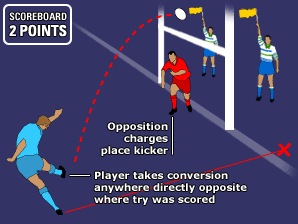Scoring points in rugby is essential to win games. There are several ways to do it.
Rugby is a thrilling sport that combines strength, strategy, and teamwork. Whether you’re new to rugby or looking to refine your skills, understanding how to score points is crucial. Points in rugby can be earned through tries, conversions, penalties, and drop goals.
Each method requires different techniques and strategies, making the game both challenging and exciting. In this guide, we’ll break down each way to score, so you can improve your game and enjoy rugby even more. Whether you play or watch, knowing how points are scored adds to the enjoyment of this dynamic sport.
Basics Of Scoring
Rugby is an exciting, fast-paced sport enjoyed by many around the world. Understanding the basics of scoring can enhance your appreciation of the game. Points in rugby come from tries, conversions, penalty kicks, and drop goals. Each scoring method has its own rules and point values. This section will explain the fundamental ways to score points in rugby.
Tries
A try is one of the main ways to score in rugby. To score a try, a player must ground the ball in the opponent’s in-goal area. This area is located beyond the goal line and between the touchlines. A try is worth five points. Players often pass the ball and evade tackles to achieve this.
Conversions
After scoring a try, a team has the chance to score extra points through a conversion. A conversion kick is taken from a spot in line with where the try was scored. The goal is to kick the ball through the opponent’s goalposts. Successfully kicking the ball over the crossbar and between the posts adds two points to the score. Conversions are crucial for maximizing the points gained from a try.
Understanding Penalties
Rugby is a thrilling sport that requires skill, strategy, and teamwork. Penalties are an important part of the game. They can change the momentum. Understanding them helps you appreciate the game more. Let’s explore common penalties and penalty goals.
Common Penalties
In rugby, players must follow strict rules. Breaking them leads to penalties. Here are some common ones:
- Offside: A player is offside if they are in front of a teammate who has the ball.
- High Tackle: Tackling an opponent above the shoulders is not allowed.
- Not Releasing: A tackled player must release the ball quickly.
- Scrum Infringements: Incorrect binding or collapsing the scrum.
- Foul Play: Includes dangerous play, striking, or misconduct.
These penalties result in a free kick or a penalty kick for the opposing team.
Penalty Goals
A penalty goal is a way to score points. It is awarded after a penalty. The team can choose to kick at the goal. This kick is taken from the place of the infringement.
Here’s how it works:
- The kicker places the ball on the ground.
- They aim to kick the ball between the goalposts and over the crossbar.
- If successful, the team scores three points.
Penalty goals are a strategic way to increase the score. Teams often choose this option for an easy three points. It is especially useful in close matches.
| Penalty | Description |
|---|---|
| Offside | A player is in front of a teammate with the ball. |
| High Tackle | Tackling above the shoulders is not allowed. |
| Not Releasing | A tackled player must release the ball quickly. |
| Scrum Infringements | Incorrect binding or collapsing the scrum. |
| Foul Play | Includes dangerous play, striking, or misconduct. |
Drop Goals
Drop goals are an important way to score points in rugby. They can change the course of a game. A drop goal is worth three points. It happens when a player kicks the ball between the goalposts during open play. Let’s explore how to set up and execute a drop goal.
Setup
First, the team must be in the opponent’s half. The kicker needs space and time. Teammates should protect the kicker from defenders. The ball must be placed correctly. Hold it with both hands and angle it down.
Execution
The kicker drops the ball to the ground. It must bounce before the kicker strikes it. Aim for the middle of the goalposts. Follow through with the kick. Precision and timing are key. Practice helps improve accuracy.
Effective Kicking Techniques
Effective kicking techniques can make a huge difference in rugby. It is not just about power; precision matters too. A good kicker can score points and help control the game. This section will explain two important kicking techniques: Place Kicking and Drop Kicking.
Place Kicking
Place kicking is a common method to score points. The ball is placed on the ground, and the kicker aims for the goalposts. This technique is usually used for conversions, penalties, and sometimes drop goals. To execute a place kick, focus on your stance. Position your body at a slight angle to the ball. This helps you generate more power and accuracy.
Before kicking, take a few steps back. Then take a few steps to the side. This creates a consistent routine. When ready, approach the ball with a controlled run-up. Keep your eyes on the ball, not the goalposts. Strike the ball with the top of your foot. Follow through with your kick to maintain accuracy.
Drop Kicking
Drop kicking is another important technique in rugby. It involves dropping the ball and kicking it as it bounces. This is often used for kick-offs, restarts, and sometimes drop goals. To perform a drop kick, hold the ball with both hands. Stand with your body facing the goalposts.
Drop the ball from waist height. Let it bounce once before you kick it. Aim to strike the ball as it rises from the bounce. Use the top of your foot for the kick. Keep your eyes on the ball throughout the process. Follow through with your kick. This helps improve accuracy and distance.
Backline Strategies
Backline strategies play a crucial role in scoring points in rugby. These strategies involve coordinated moves among the backs, aiming to create gaps in the opponent’s defense. Effective backline play can lead to successful tries and convert opportunities into points. Here, we will focus on two essential aspects of backline strategies: Passing Drills and Line Breaks.
Passing Drills
Passing is fundamental in rugby. Practicing passing drills helps improve accuracy and speed. Players should practice different types of passes. The pop pass, spin pass, and switch pass are key techniques. These drills should be done under pressure to simulate real-game situations. Quick and precise passing can outmaneuver defenders and create scoring chances.
Line Breaks
Line breaks are critical for advancing the ball. They occur when a player penetrates the opponent’s defensive line. To achieve this, players need good timing and support. Running lines must be sharp and well-coordinated. Supporting players should follow closely to exploit any gaps created. Effective line breaks can lead to significant territorial gains and scoring opportunities.

Credit: www.youtube.com
Forwards’ Role In Scoring
In rugby, forwards play a crucial role in scoring points. They use their strength and skills to gain ground and create opportunities. Their efforts often lead to tries, conversions, and penalties. Understanding their tactics can improve a team’s performance on the field.
Scrum Tactics
Scrums are set-piece plays where forwards compete for the ball. The goal is to win possession and gain an advantage. Here are some key tactics:
- Bind correctly: Ensure a solid and secure binding with teammates.
- Maintain body position: Keep a low and strong stance to push effectively.
- Coordinate timing: Push together as a unit to overpower the opposition.
- Use power: Drive through the opposition to gain control of the ball.
Maul Strategies
Mauls are formed when a player with the ball is held up but not tackled. Other players join to push forward. Effective maul strategies include:
| Strategy | Description |
|---|---|
| Form quickly | Get players into position fast to maintain momentum. |
| Stay bound | Keep a tight formation to protect the ball carrier. |
| Drive forward | Push as a unit to gain ground and break through the defense. |
| Control the ball | Keep the ball at the back of the maul for better management. |
Forwards using these tactics can create scoring opportunities. They often set up tries or earn penalties. Proper execution of scrums and mauls is essential for a successful team.
Team Coordination
Team coordination is essential for scoring points in rugby. Players must work together seamlessly. This means communicating effectively, supporting each other, and making quick decisions. The following sections will explore two key aspects of team coordination: communication and support play.
Communication
Effective communication is vital on the rugby field. Players need to talk to each other constantly. This helps in making fast decisions. Clear calls can guide teammates to the right position. Simple words or signals can make a big difference. Everyone should know the team’s plan and the opponent’s weaknesses. This shared understanding leads to better coordination.
Support Play
Support play ensures that players are always ready to assist. Teammates should be near the ball carrier. This provides options for passing and reduces the risk of losing possession. Support players can also create space by drawing defenders away. They must anticipate the ball carrier’s moves and react quickly. Strong support play keeps the attack fluid and dynamic.

Credit: news.bbc.co.uk
Mental Preparation
Mental preparation is crucial for scoring points in rugby. It helps players focus, stay calm, and perform at their best. By using focus techniques and handling pressure, players can improve their game significantly.
Focus Techniques
Focus is vital in rugby. Players must concentrate on the game and their role. One effective technique is visualization. Imagine successfully scoring points. Picture the field, the ball, and the movements. This helps build confidence and clarity.
Another technique is deep breathing. Take slow, deep breaths to calm the mind. This reduces anxiety and increases concentration. Practice these techniques regularly to improve focus during matches.
Handling Pressure
Pressure is a part of rugby. Players must learn to handle it well. One way is to stay positive. Keep a positive mindset, even when things go wrong. This helps maintain composure and focus.
Another method is to break the game into smaller tasks. Focus on the next pass, tackle, or run. This makes the game less overwhelming and easier to manage. Remember, mental strength is as important as physical skill in rugby.

Credit: www2.gvsu.edu
Frequently Asked Questions
How Do You Score A Try In Rugby?
A try is scored by grounding the ball in the opponent’s in-goal area. It is worth 5 points.
What Is A Conversion In Rugby?
A conversion is a kick at goal following a try. It is worth 2 points.
How Much Is A Penalty Kick Worth?
A penalty kick in rugby is worth 3 points. It is awarded for certain infringements.
What Is A Drop Goal In Rugby?
A drop goal is scored by kicking the ball through the goalposts during open play. It is worth 3 points.
Conclusion
Scoring in rugby can be fun and rewarding. Follow basic rules and practice often. Understand the different ways to score. Try conversions, penalties, and drop goals. Teamwork is crucial. Good communication helps a lot. Watch professional games and learn from them.
Keep improving your skills. Enjoy the sport and have fun. Happy playing!


